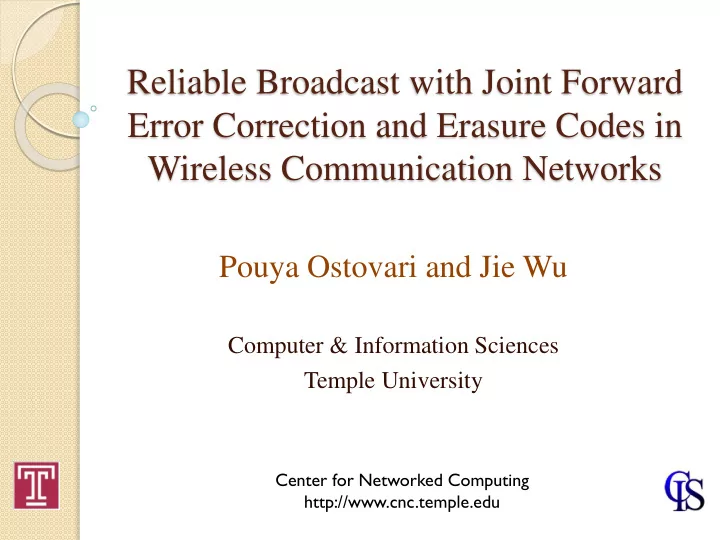

Reliable Broadcast with Joint Forward Error Correction and Erasure Codes in Wireless Communication Networks Pouya Ostovari and Jie Wu Computer & Information Sciences Temple University Center for Networked Computing http://www.cnc.temple.edu
Agenda Introduction ◦ Motivation Cross-layer protection ◦ Formulation ◦ Proposed method Evaluations Conclusions 2
Introduction Advances in technology of mobile devices ◦ Smartphones and tablets Wireless connections ◦ Are widely used ◦ Internet is accessible everywhere Reliable transmission ◦ ARQ ◦ Erasure codes ◦ Hybrid-ARQ ◦ Fountain codes (rateless codes) 3
Transmission Errors Noise ◦ Forward error correcting codes (FEC) ◦ Adding redundant bits to find and correct bit errors ◦ Physical layer Interference ◦ Packet erasure codes (EC) ◦ Transmitting redundant packets ◦ Application and network layers 4
Network Coding Random linear network coding ◦ Linear combinations of the packets ◦ Gaussian elimination 𝑟 1 = 𝛽 1,1 𝑞 1 + 𝛽 1,2 𝑞 2 + 𝛽 1,3 𝑞 3 𝑟 2 = 𝛽 2,1 𝑞 1 + 𝛽 2,2 𝑞 2 + 𝛽 2,3 𝑞 3 … 𝑟 n = 𝛽 𝑜,1 𝑞 1 + 𝛽 𝑜,2 𝑞 2 + 𝛽 𝑜,3 𝑞 3 Applications of network coding ◦ Reliable transmissions ◦ Throughput/capacity enhancement Distributed storage systems/ Content distribution/ Layered multicast 5
Cross-Layer Reliable Transmission Joint FEC and EC ◦ Deciding about the amount of redundancy to be added for FEC and EC Previous work ◦ Theoretic result for the case of single destination ◦ Muriel Medard: implementation on sensor network Shows that joint FEC-NC is effective Depending on noise and interference level, more NC or FEC redundancy enhances the reliability No method for redundancy distribution 6
Setting Single source ◦ Transmits a set of m packets ◦ Size of each packet: n bits ◦ Source can transmit X bits Two sources of errors ◦ Noise and interference ◦ Different noise and interference probabilities 7
Setting Provide protection for the packets ◦ Joint FEC and NC Objective ◦ Finding the optimal transmission scheme that maximizes the probability of receiving the m packets by the destinations 8
Joint Coding Scheme Segmentation 1. 2. Applying network coding 3. Adding FEC to each network coded packet NC FEC 9
Problem Formulation Erasure due to noise ◦ When bit errors cannot be corrected Erasure due to noise and interference Successful transmission of the m packets 10
Problem Formulation 11
Finding Optimal Distribution The probability equation cannot be simplified into a closed-form Two-phases algorithm ◦ Offline phase: creating a reference table which shows the success delivery of the packets for each possible FEC and NC redundancy levels ◦ Online phase: performing a search on reference table to find the optimal FEC and NC levels Depending on the noise and interference probabilities of the users 12
Reference Table Creation 13
Search for Optimal Coding Scheme 1 14
Evaluations Simulator in Matlab environment 1000 topologies with random bit error rate and interference probability Bit error rate and interference probability of the destinations are independent Comparing with only FEC and only NC methods 15
Evaluations 100 sets of packets ◦ Each set contains 10 packets 16
Evaluations 100 sets of packets ◦ Each set contains 10 packets 17
Evaluations 100 sets of packets ◦ Each set contains 10 packets 18
Evaluations 100 sets of packets ◦ Each set contains 10 packets 19
Simulation Summary For low noise probability FEC provides a better protection As noise or interference probability increases, more redundancy is needed for NC (EC) ◦ FEC performs poorly FEC or NC? ◦ For a given noise and interference probability, that depends on X 20
Conclusion Cross-layer protection of transmitted packets Joint FEC and NC to enhance reliability Fixed redundancy Finding the optimal transmission scheme ◦ FEC redundancy ◦ NC redundancy (erasure code) Two-phases algorithm ◦ Offline and online phases 21
Thank you 22
Recommend
More recommend